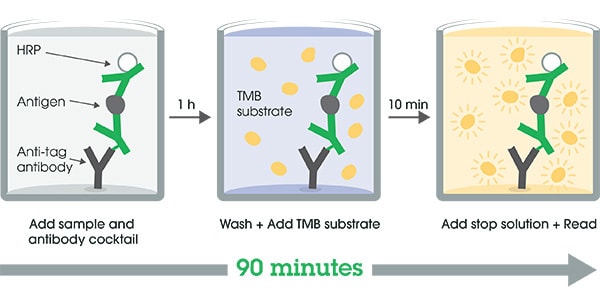Rat CXCL7 / PBP ELISA Kit (ab239429)
Key features and details
- One-wash 90 minute protocol
- Sensitivity: 0.301 pg/ml
- Range: 1.95 pg/ml - 125 pg/ml
- Sample type: Hep Plasma, Serum
- Detection method: Colorimetric
- Assay type: Sandwich (quantitative)
- Reacts with: Rat
Overview
-
Product name
Rat CXCL7 / PBP ELISA Kit
See all CXCL7/PBP kits -
Detection method
Colorimetric -
Precision
Intra-assay Sample n Mean SD CV% serum 8 3.3% Inter-assay Sample n Mean SD CV% serum 3 9.9% -
Sample type
Serum, Hep Plasma -
Assay type
Sandwich (quantitative) -
Sensitivity
0.301 pg/ml -
Range
1.95 pg/ml - 125 pg/ml -
Recovery
Sample specific recovery Sample type Average % Range Serum 108 103% - 118% Hep Plasma 103 93% - 119% -
Assay time
1h 30m -
Assay duration
One step assay -
Species reactivity
Reacts with: Rat -
Product overview
Rat CXCL7 / PBP ELISA Kit (ab239429) is a single-wash 90 min sandwich ELISA designed for the quantitative measurement of CXCL7 / PBP protein in hep plasma and serum. It uses our proprietary SimpleStep ELISA® technology. Quantitate Rat CXCL7 / PBP with 0.301 pg/ml sensitivity.
SimpleStep ELISA® technology employs capture antibodies conjugated to an affinity tag that is recognized by the monoclonal antibody used to coat our SimpleStep ELISA® plates. This approach to sandwich ELISA allows the formation of the antibody-analyte sandwich complex in a single step, significantly reducing assay time. See the SimpleStep ELISA® protocol summary in the image section for further details. Our SimpleStep ELISA® technology provides several benefits:
- Single-wash protocol reduces assay time to 90 minutes or less
- High sensitivity, specificity and reproducibility from superior antibodies
- Fully validated in biological samples
- 96-wells plate breakable into 12 x 8 wells stripsA 384-well SimpleStep ELISA® microplate (ab203359) is available to use as an alternative to the 96-well microplate provided with SimpleStep ELISA® kits.
-
Platform
Pre-coated microplate (12 x 8 well strips)
Properties
-
Storage instructions
Store at +4°C. Please refer to protocols. -
Components 1 x 96 tests 10X Rat CXCL7 / PBP Capture Antibody 1 x 600µl 10X Rat CXCL7 / PBP Detector Antibody 1 x 600µl 10X Wash Buffer PT (ab206977) 1 x 20ml Antibody Diluent 4BR 1 x 6ml Plate Seals 1 unit Rat CXCL7 / PBP Lyophilized Recombinant Protein 2 vials Sample Diluent NS (ab193972) 1 x 50ml SimpleStep Pre-Coated 96-Well Microplate (ab206978) 1 unit Stop Solution 1 x 12ml TMB Development Solution 1 x 12ml -
Research areas
-
Function
LA-PF4 stimulates DNA synthesis, mitosis, glycolysis, intracellular cAMP accumulation, prostaglandin E2 secretion, and synthesis of hyaluronic acid and sulfated glycosaminoglycan. It also stimulates the formation and secretion of plasminogen activator by human synovial cells. NAP-2 is a ligand for CXCR1 and CXCR2, and NAP-2, NAP-2(73), NAP-2(74), NAP-2(1-66), and most potent NAP-2(1-63) are chemoattractants and activators for neutrophils. TC-1 and TC-2 are antibacterial proteins, in vitro released from activated platelet alpha-granules. CTAP-III(1-81) is more potent than CTAP-III desensitize chemokine-induced neutrophil activation. -
Sequence similarities
Belongs to the intercrine alpha (chemokine CxC) family. -
Post-translational
modificationsProteolytic removal of residues 1-9 produces the active peptide connective tissue-activating peptide III (CTAP-III) (low-affinity platelet factor IV (LA-PF4)).
Proteolytic removal of residues 1-13 produces the active peptide beta-thromboglobulin, which is released from platelets along with platelet factor 4 and platelet-derived growth factor.
NAP-2(1-66) is produced by proteolytical processing, probably after secretion by leukocytes other than neutrophils.
NAP-2(73) and NAP-2(74) seem not be produced by proteolytical processing of secreted precursors but are released in an active form from platelets. -
Cellular localization
Secreted. - Information by UniProt
-
Alternative names
- B TG1
- Beta TG
- Beta thromboglobulin
see all -
Database links
Images
-
SimpleStep ELISA technology allows the formation of the antibody-antigen complex in one single step, reducing assay time to 90 minutes. Add samples or standards and antibody mix to wells all at once, incubate, wash, and add your final substrate. See protocol for a detailed step-by-step guide.
-
The CXCL7 standard curve was prepared as described in Section 10. Raw data values are shown in the table. Background-subtracted data values (mean +/- SD) are graphed.
-
The concentrations of CXCL7 were measured in duplicate, interpolated from the CXCL7 standard curves and corrected for sample dilution. Undiluted samples are as follows: serum 1:80000, and plasma (heparin) 1:2000. The interpolated dilution factor corrected values are plotted (mean +/- SD, n=2). The mean CXCL7 concentration was determined to be 3427.34 ng/mL in serum and 84.11 ng/mL in plasma (heparin).
-
To learn more about the advantages of recombinant antibodies see here.












